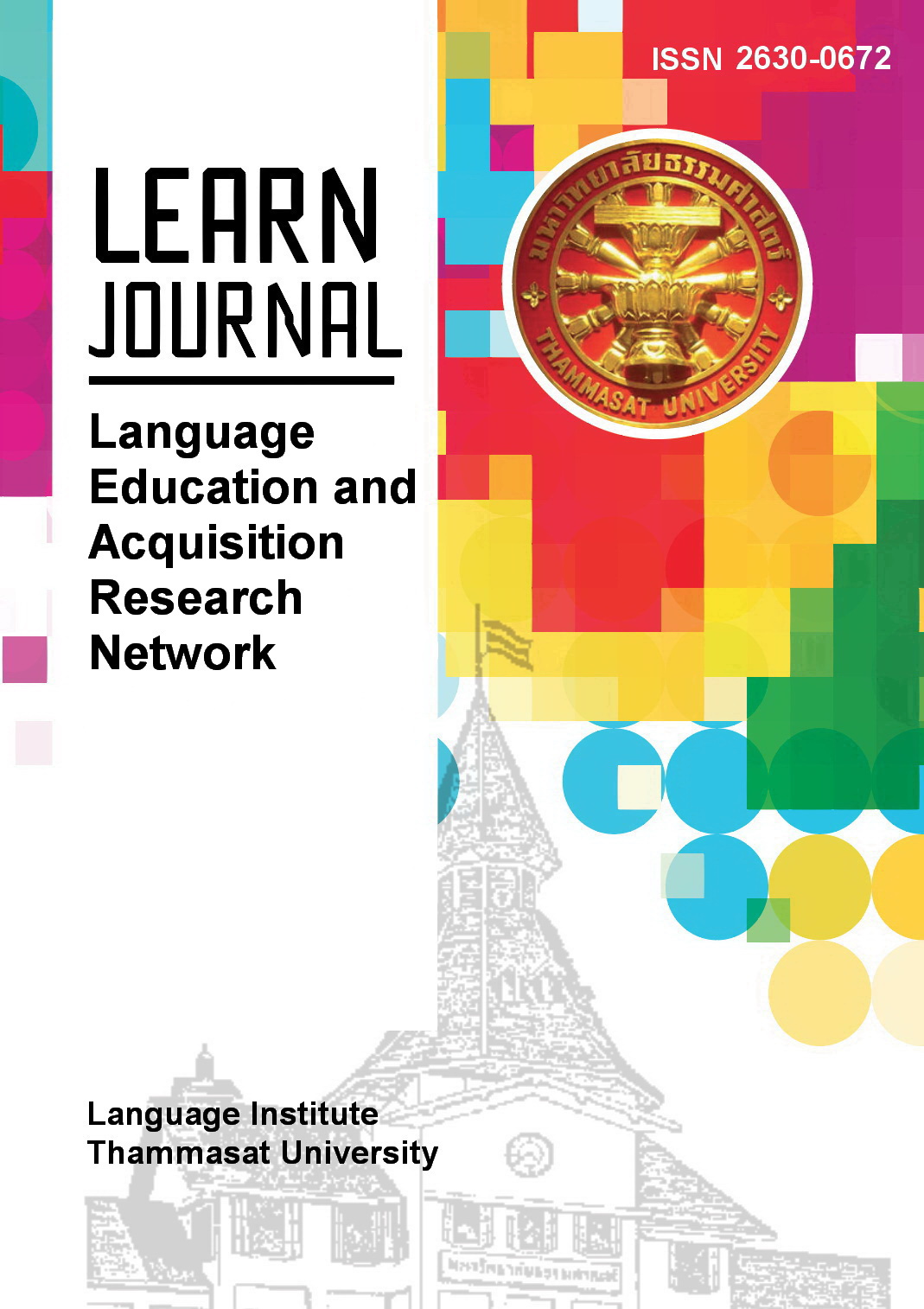A Corpus-based Study of English Synonyms Clear, Obvious, Apparent, and Evident: Implications for ELT
Main Article Content
Abstract
This study analyzes four English synonyms -- clear, obvious, apparent, and evident -- concentrating on meanings, distribution across genre, collocations, and semantic preference and prosody. The data were drawn from learner’s dictionaries and the Corpus of the Contemporary American English (COCA). It was discovered that the four synonyms share the same core meaning but differ in terms of detailed meanings, collocations, semantic preference, and semantic prosody. Apparent and evident were found to be the most formal synonyms in this study. Obvious is mostly associated with negative meanings. Clear has a wide range of detailed meanings and is usually involved with nature and the physical world. The results of this study also shed light on ELT as they can guide teachers and students in practicing skills of corpora and applying them to classroom, autonomously.
Article Details
References
Bergdahl, M. (2009). Is he beautiful, handsome or good-looking: A study of putative synonymy in three adjectives. Master’s thesis. Lulea University of Technology, Lulea, Sweden.
Chung, S.-F. (2011). A corpus-based analysis of “create” and “produce.” Chang Gung Journal of Humanities and Social Sciences, 4(2), 399–425. Coxhead, A. (2000). A new academic word list. TESOL Quarterly, 34(2), 213–238. https://doi.org/10.2307/3587951
Crawford, W. J., & Csomay, E. (2016). Doing corpus linguistics. Routledge.
Davies, M. (2020). English corpora. English-corpora. Retrieved March 29, 2023, from https://www.english- corpora.org/coca/help/coca2020_overview.pdf
Flowerdew, J. (2013). Discourse in English language education. Routledge.
Flowerdew, L. (2012). Corpora and language education. Palgrave Macmillan.
Gu, B. J. (2017). Corpus-based study of two synonyms—obtain and gain.Sino-US English Teaching, 14(8), 511–522. https://doi.org/10.17265/1539-8072/2017.08.006
Jackson, H., & Amvela Zé Etienne. (2000). Words, meaning and vocabulary: An introduction to modern English lexicology (2nd ed.). Athenaeum Press.
Jarunwaraphan, B., & Mallikamas, P. (2020). A corpus-based study ofEnglish synonyms: Chance and opportunity. REFLections, 27(2),218–245. Retrieved from https://so05.tci-thaijo.org/index.php/reflections/article/view/248710
Jenkins, J. (2009). English as a lingua franca: Interpretations and attitudes.World Englishes, 28(2), 200–207. https://doi.org/10.1111/j.1467-971x.2009.01582.x
Laufer, B. (1990). Words you know: How they affect the words you learn.Further Insights into Contrastive Analysis, 30, 573–593. https://doi.org/10.1075/llsee.30.35lau
Lehecka, T. (2015). Collocation and colligation. In J.-O. Östman, & J. Verschueren (Eds.), Handbook of pragmatics online. Amsterdam: Benjamins. https://doi.org/10.1075/hop.19.col2
Lindquist, H. (2009). Corpus linguistics and the description of English. Edinburgh University Press. Longman Dictionary of Contemporary English Online. LDOCE. (n.d.). RetrievedMarch 29, 2023, from https://www.ldoceonline.com/ Ma, Q., Tang, J., & Lin, S. (2021). The development of corpus-based language pedagogy for TESOL teachers: A two-step training approach facilitated by online collaboration. Computer Assisted Language Learning, 35(9), 2731–2760. https://doi.org/10.1080/09588221.2021.1895225
McIntosh, C. (2014). Cambridge advanced learner's dictionary. Cambridge University Press.
Nation, I. S. P. (1983). Teaching and learning vocabulary. Victoria University of Wellington English Language Institute. Nelson, M. (2006). Semantic associations in business English: A corpus-based analysis. English for Specific Purposes, 25(2), 217–234. https://doi.org/10.1016/j.esp.2005.02.008
Oxford University Press. (n.d.). Clear. oxfordlearnersdictionaries.com/definition/english. Retrieved May 20, 2023, from https://www.oxfordlearnersdictionaries.com/definition/english/clear_1?q=clear Palmer, F. R. (1997). Semantics. Cambridge University Press.
Partington, A. (1998). Patterns and meanings: Using corpora for English language research and teaching. Vol. 2. John Benjamins Publishing. Partington, A. (2004). "Utterly content in each other's company": Semantic prosody and semantic preference. International Journal of Corpus Linguistics, 9(1), 131–156. https://doi.org/10.1075/ijcl.9.1.07par
Petcharat, N., & Phoocharoensil, S. (2017). A corpus-based study of English synonyms: Appropriate, proper, and suitable. LEARN Journal: Language Education and Acquisition Research Network, 10(2), 10– 24. Retrieved from https://so04.tci- thaijo.org/index.php/LEARN/article/view/111700
Phoocharoensil, S. (2010). A corpus-based study of English synonyms. International Journal of Arts and Sciences, 3(10), 227-245. Phoocharoensil, S. (2020). A genre and collocational analysis of consequence, result, and outcome. 3L The Southeast Asian Journal of English Language Studies, 26(3), 1–16. https://doi.org/10.17576/3l-2020-2603-01
Phoocharoensil, S. (2021). Semantic prosody and collocation: A corpus study of the near-synonyms persist and persevere. Eurasian Journal of Applied Linguistics, 7(1), 240–258. https://doi.org/10.32601/ejal.911269
Schmitt, N. (2010). Researching vocabulary: A vocabulary research manual. Palgrave Macmillan. Stubbs, M. (1996). Text and corpus analysis. Blackwell.
Timmis, I. (2015). Corpus linguistics for ELT research and practice. Routledge.
Webb, S. & Nation, I. S. P. (2017). How vocabulary is learned. Oxford University Press: Oxford, UK, 2017.


